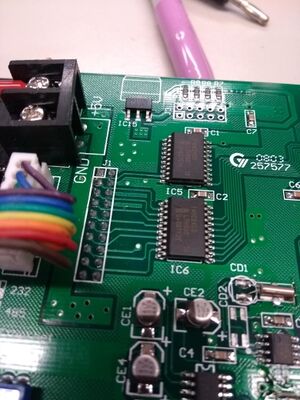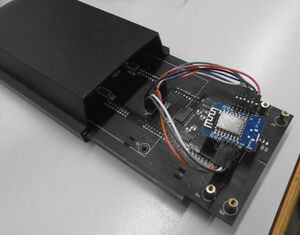LichtKrant: Difference between revisions
(→Links) |
|||
| Line 175: | Line 175: | ||
Possibly useful other info: | Possibly useful other info: | ||
* https://medium.com/@tharindu_peiris/p10-led-display-panel-using-esp8266-wemos-d1-mini-nodemcu-1e463ad60722 | * https://medium.com/@tharindu_peiris/p10-led-display-panel-using-esp8266-wemos-d1-mini-nodemcu-1e463ad60722 | ||
* some fonts for rendering text on 7-pixel high https://damieng.com/blog/2011/02/20/typography-in-8-bits-system-fonts | |||
Revision as of 14:08, 26 December 2019
| Project LichtKrant | |
|---|---|

| |
| Controller for 3-colour 80x7 pixel moving LED sign | |
| Status | In progress |
| Contact | bertrik |
| Last Update | 2019-12-26 |
Introduction
Found a moving LED sign on the revspace free stuff table.
It is 80 pixels wide, 7 pixels high. Each pixel has two sub-pixels (red and green), so it can display 3 colours (off, red, orange, green)
Goals:
- reverse engineer the electronics and document how it works -> DONE
- replace the controller board with an ESP, so we can receive image/text updates over the network -> DONE
- implement more colour depth, so we can display gradient bitmaps (not just red, green, orange) -> DONE
- write software for this, so other people can do the same for their display -> IN PROGRESS
Next:
- pixelflut server, as described here, just skip the blue channel
- getting it to work on a network, see if it impacts performance, visual quality
Future ideas:
- generic receiver process for image frames (80x7 RGB, in UDP or TCP/IP)
- replicate the existing 80x8 display at revspace, but with one less row and no blue LEDs
- double buffering, or some other kind of sync mechanism/callback?
Reverse engineering
It consists of a processor board and a LED board.
Processor board
The processor board has a 8052, a flash chip, battery, 32768 Hz crystal, 40 MHz crystal, Altera Max chip. It appears the Altera chip drives two 245 chips which in turn drive the signal to the connector J1 to the LED board.
It takes 5V as input.
The PCB has a text on it: HXITC017_2.PCB
LED board
The LED board contains the actual pixels, organized in 16 modules of 5x7 LEDs. Each LED has a red sub-pixel and a green sub-pixel, so it can do colors: red, green, orange. The LED modules have the text GYXM-G2357ASRG on them.
The PCB has a text on it: HXBI80070509.PCN, date 2007-12-28
The are already electronics on it, consisting mostly of 595 chips (serial shift registers). The are two chains of 10 pieces of 74hc595 chips each, controlling the columns. There is an '138 chip (3-to-8 decoder) that drives a set of MOSFETS, 7 in total, controlling the rows. The MOSFETs are SDM4953, dual P-channel MOSFETs.
How does it work
Finding out how it works is done by tracing out the connections from connector J1, which connects the processor board to the LED board.
* J1.1: IC2.A1 -> IC2.B1 -> via ... -> shift clock
-> IC1.B1 -> IC1.A1 -> U11.SRCLK
-> IC1.B6 -> IC1.A6 -> U1.SRCLK
* J1.2: GND
* J1.3: IC2.A2 -> IC2.B2 -> via ... -> latch clock
* IC1.B2 -> IC1.A2 -> U11.RCLK
* IC1.B5 -> IC1.A5 -> U1.RCLK
* J1.4: GND
* J1.5: IC1.B3 -> IC1.A3 -> U11.SER -> data pin for upper shift register (green)
* J1.6: GND
* J1.7: IC1.B4 -> IC1.A4 -> U1.SER -> data pin for lower shift register (red)
* J1.8: GND
* J1.9: IC2.A7 -> IC2.B7 -> via ... -> row enable
IC4.1A -> IC4.1Y -> IC3.G2B
* J1.10: VCC
* J1.11: IC2.A3 (row) -> IC3.A -> row select
* J1.12: VCC
* J1.13: IC2.A4 (row) -> IC3.B -> row select
* J1.14: VCC
* J1.15: IC2.A5 (row) -> IC3.C -> row select
* J1.16: J4 (IR receiver)
* J1.17: IC2.A6 -> IC2.B6 -> IC3.G2A -> row enable?
* J1.18: ???
* J1.19: ???
* J1.20: connected to the "ethernet" dipswitch
- IC1 = 74HC245 (octal buffer) on LED board
- IC2 = 74HC245 (octal buffer) on LED board
- IC3 = 74HC138 (3-8 mux) on LED board
- IC4 = 74HC04 (hex inverter) on LED board
- U1-U10 = lower chain of 74HC595 (8-bit shift register)
- U11-U20 = upper chain of 74HC595 (8-bit shift register)
The 74HC138 has an enable consisting of three signals G1, G2A, G2B. Signal G1 is connected to Vcc. Signal G2A is connected to B6 Signal G2B is connected through a hex inverter (IC4.1Y) -> IC4.A -> IC2.A7 -> IC2.B7
There are 8 rows (3 bits) controlled by the 74HC138 and 8 MOSFETS and two chains of 10x 74HC595 (8-bit shift registers) for the columns.
In summary, connector J1 has the following signals:
- columns
- 1 bit shift clock shared for both shift registers (J1.1)
- 1 bit latch clock shared for both shift registers (J1.3)
- 1 data bit for 80-bit shift register 1 (J1.5)
- 1 data bit for 80-bit shift register 2 (J1.7)
- rows
- 2 bits row enable (J1.9 and J1.17)
- 3-bits row select (J1.11, J1.13, J1.15)
- other
- 5V signals
- GND signals
- some signal for the infared remote control
Levels on the bus are 5V.
Theory of operation:
- software writes two rows (red and green) of 80 bits into the shift register, using the shift clock lines and two SER lines
- software latches the data from the shift registers into the LED row output registers
- software selects a row using the three rows select lines and the row enable signals
- wait a few ms while the LED row it lit
- next row
Timing
Some measurements on the timing of the signal with the original control board connected.
- The bit shift clock is about 300 ns high, 300 ns low. Frequency about 1.67 MHz.
- Row bytes are sent with an 9.6 us interval.
- The column latch clock pulses with an interval of 384 us, it's a positive going pulse about 300 ns long. This means a line rate of about 2.6 kHz.
- Row enable on J1.9 has an interval of 384 us, with a low-time of about 80 us.
- Row enable on J1.17 has an interval of about 6.16 ms, with a low-time of about 3.08 ms. This is relatively slow. My guess is that this is a kind of global brightness control PWM signal.
Columns:
- J1.11 (row select): 0.37 ms high, 0.37 ms low
- J1.13 (row select): 0.76 ms high, 0.76 ms low
- J1.15 (row select): 1.5 ms high, 1.5 ms low
-> the rows cycle through 8 states (although there are only 7 rows) -> the entire cycle takes about 3 ms, so the frame rate is about 300 Hz -> each row is enabled for 0.37 ms, consistent with the row column latch interval
Power consumption
The duty cycle of the LEDs is strongly determined by the row enable pins. It appears that J1.17 is used by the original control board to set the global brightness.
- all LEDs off, about 20 mA
- all red LEDs on, about 4.0 A
- all green LEDs on, about 3.7 A
- all LEDs (red + green) on, about 6.4 A
Hardware modifications
So far I've made the following modifications:
- added a power connector on the footprint that was already present, 5V is supplied there (up to 6 Amps!)
- removed the controller board
- added a Wemos D1 mini board, see the source code (leddriver.cpp) for the pinout
Software
Preliminary code can be found on the github lichtkrant repository.
The moving LED sign is driven using an ESP8266.
The LED driver handles one line at a time. It is driven by the interrupt handler of timer1.
The way, we get steady timing for real-time driving of the display. The main execution context is still free to do other stuff.
variable pixel brightness
Variable pixel is implemented using a kind of duty-cycle/dithering modulation:
- For each pixel we keep a running brightness count (e.g. 8-bit).
- At each frame start, for each pixel, we add the brightness value from the frame buffer to the brightness count (e.g. 0-255). If the addition results in an overflow, the pixel is lit on the display, otherwise it is dimmed. For example, adding a brightness value of 128 causes the addition to overflow every other time, causing a 50%/50% duty cycle at half the update frequency.
- The running brightness count is initialized with a random number, this avoids synchronized flashing of the pixels on the display. In other words, pixels with the same brightness have the same duty cycle, but have staggered turn-of/turn-off times with respect to each other.
- The above is implemented for the red and green pixels separately.
Links
Possibly useful other info:
- https://medium.com/@tharindu_peiris/p10-led-display-panel-using-esp8266-wemos-d1-mini-nodemcu-1e463ad60722
- some fonts for rendering text on 7-pixel high https://damieng.com/blog/2011/02/20/typography-in-8-bits-system-fonts

